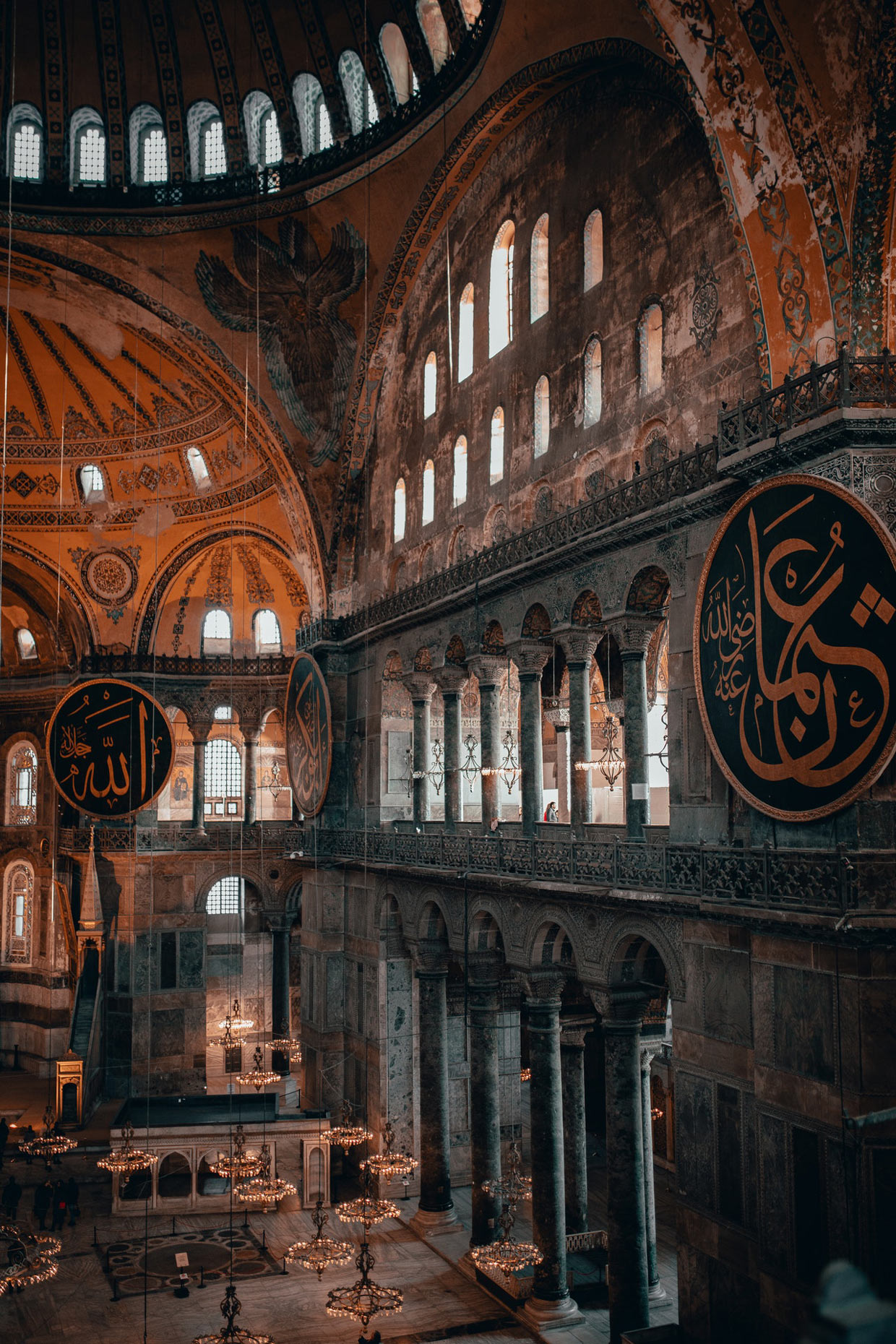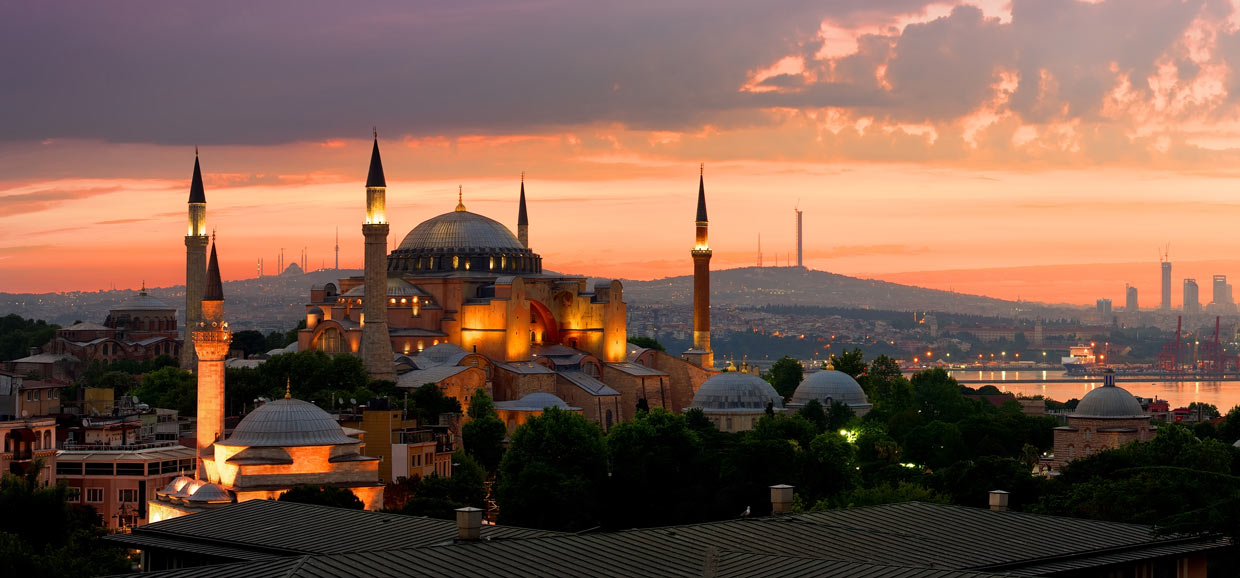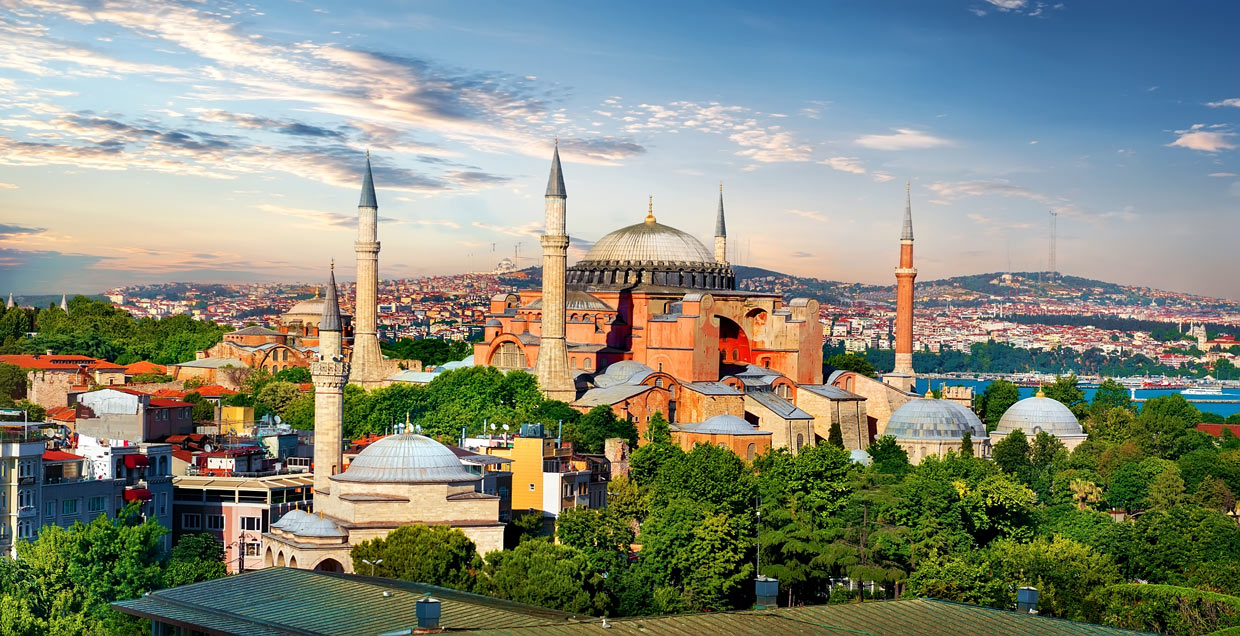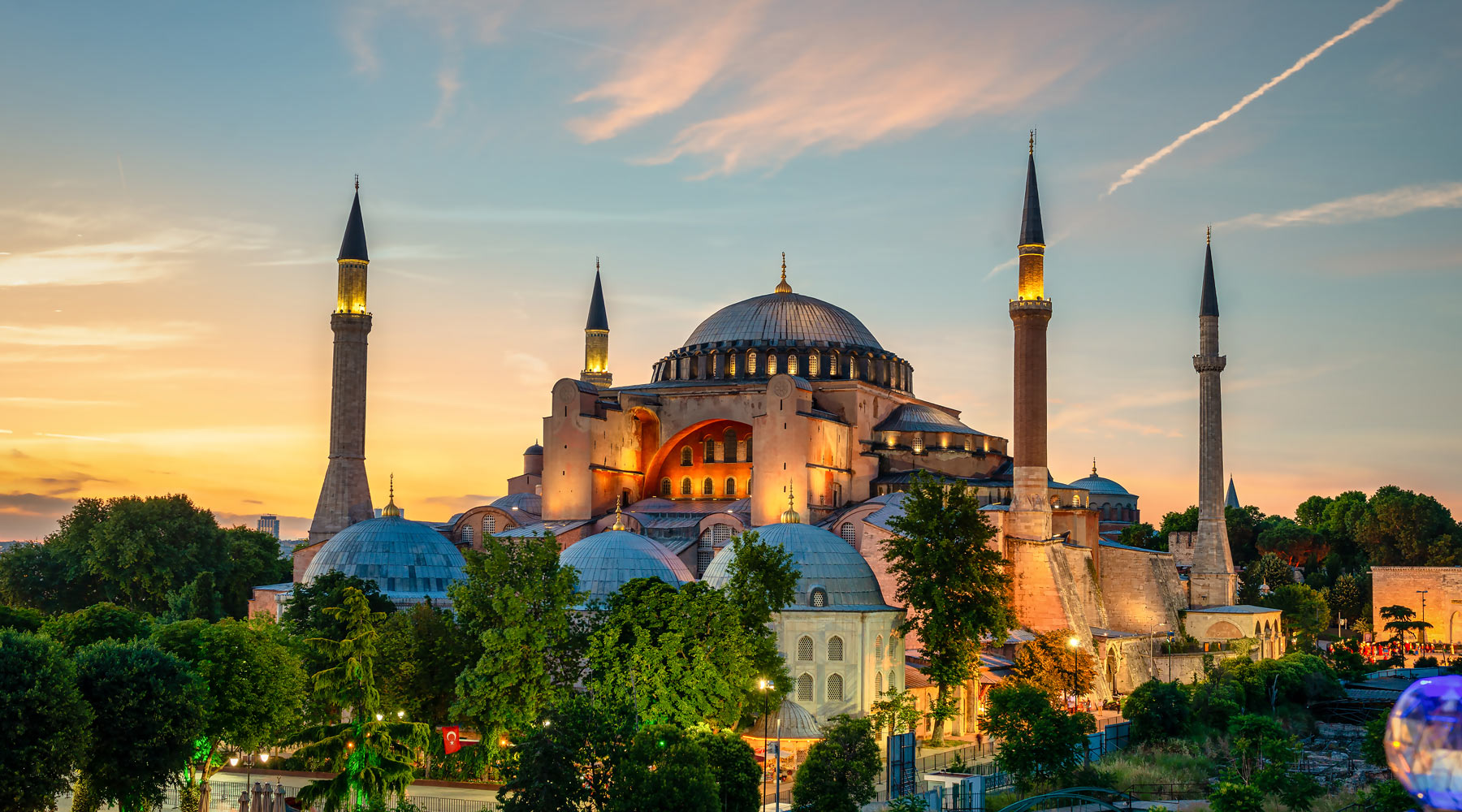The Hagia Sophia Mosque is a 6th-century architectural marvel of the Byzantine Empire in Istanbul. Known as Ayasofya by the Turks and Sancta Sophia in Latin, this monumental structure has evolved over the centuries—transforming from a church into a mosque, then a museum, and, most recently, reverting back to its role as a mosque. Its extraordinary history and remarkable design make it one of the most visited attractions in Turkey as of 2023.
Perched on Istanbul’s historical European side, in the old district, the Hagia Sophia showcases a legacy that spans different eras and cultures. Despite changes such as the transition from Constantinople to Istanbul, the name itself preserves its Greek and Latin origins. Don’t miss the opportunity to explore this impressive place of worship when you visit Turkey.
History of Hagia Sophia
Originally built in 537 AD during the reign of Justinian I in what was then the capital of the Byzantine Empire, Constantinople, Hagia Sophia was conceived as a testament to imperial power and divine wisdom. “Sophia” translates to “wisdom” in Greek, reflecting a deep commitment to intellectual and spiritual legacy. Though often referred to as Sancta Sophia, this title does not reference any singular martyr but denotes a broader dedication to holy wisdom.
The current structure, crowned by a grand 32-meter dome, is actually the third church to have been built on this storied site. Over the centuries, it has withstood the trials of natural disasters, conflicts, and numerous reconstructions as control of the city shifted from the Byzantines to the Ottomans and finally to the modern Turkish state. The intricate mosaics, lavish decorations, and historical details make this monument a can’t-miss landmark.

If you are interested in the layered history of this extraordinary site, it’s fascinating to note that three distinct churches have been built on this very same spot:
Church of Constantius II – The First Hagia Sophia
During his reign from 337 to 361 AD, Emperor Constantius II commissioned the original church. Constructed primarily of wood, including its wooden roof, this first version of Hagia Sophia was tragically lost to fire in the early fifth century. Despite its short-lived glory, it was considered one of the largest churches of its time—a record that would stand for almost a millennium.
While definitive details of its architectural features remain scarce, historical descriptions and scholarly theories have contributed to our understanding of how this sacred space might have appeared in its prime.
Church of Theodosius II – The Reborn Hagia Sophia After the Fire
Following the devastating fire, Theodosius II took on the colossal task of rebuilding the church in 415 AD. Designed to echo the original, the reconstruction continued to face west—maintaining the spiritual and architectural traditions of its predecessor. Unfortunately, from this period too, little remains above ground today.
Excavations conducted in the 1930s unearthed stone fragments believed to be remnants of the original entrance. These archaeological discoveries offer precious insights into the relics and artifacts that once adorned this early iteration of Hagia Sophia.
The Current Hagia Sophia – The Church of Justinian I
The pivotal moment in Hagia Sophia’s history came in January 532 AD during the Nika Revolt, when the Church of Theodosius II was devastated by fire. Not long after, Emperor Justinian I commissioned a bold reconstruction project at the very same site. This time, the architects Anthemius of Tralles and Isidore of Miletus envisioned a monument that would outshine its predecessors.

In contrast to earlier versions, this structure was built with more durable materials—predominantly marble, brick, and plaster—that resemble modern construction in many ways. Enhanced with lavish decorations of gold and precious gems, Justinian I’s masterpiece reflected the zenith of Byzantine artistic and engineering ingenuity. The building’s colossal size allowed it to be seen from the sea, an enduring symbol of imperial might and religious devotion.
Remarkably, the entire construction—carried out by thousands of workers—was completed in just six years. This feat speaks not only to the meticulous planning but also to the deep cultural reverence that drove the Byzantines to create a monument for the ages.
After centuries as a revered Christian church, the tides of history turned in 1453 when Ottoman forces, led by Sultan Mehmed II, captured Constantinople. Following their conquest, the Hagia Sophia was transformed to suit Islamic traditions. The Ottomans performed the Friday (Jumma) Prayer, converting the cathedral into a majestic mosque, an event that forever changed its architectural narrative.

During the Ottoman era, some of the original Christian relics and decorations were desecrated or removed after the building was sacked by soldiers. Despite these losses, the structure retained much of its ancient charm even as it was reimagined as a monument of Islamic art and culture. When Constantinople’s name gradually evolved into Istanbul, the preserved name of Hagia Sophia continued to honor its grand heritage.
Waqf and Islamic Architectural Changes
With its designation as a waqf—a charitable trust ensuring its perpetual use for Islamic worship—the Hagia Sophia underwent significant modifications to align with Islamic principles. Four minarets were added at different intervals during the Ottoman period to signal its new identity as a mosque. The interior was modified with the addition of a Mihrab to indicate the Qibla, the direction of Mecca, alongside ornate calligraphy and carpets that now grace the floor.
These alterations were carefully balanced with the preservation of the monument’s original Byzantine artistry. The Byzantine mosaics and marble columns continue to narrate the rich past of this historic structure, ensuring that both the Christian and Islamic legacies speak together in a unique dialogue of art and faith.
Ayasofya Museum
In 1935, a significant shift occurred when Mustafa Kemal Atatürk, the founder of the Turkish Republic, converted the Hagia Sophia into a museum as part of broader efforts to secularize Turkey. During this period, renovations sought to carefully reintroduce and highlight its Byzantine mosaics and heritage elements that had been hidden or altered over the centuries. In 1985, it was recognized as a UNESCO World Heritage Site, joining other nearby treasures such as the Topkapi Palace.

Hagia Sophia as a Mosque Again
In 2020, after years of debate and controversy, the status of the Hagia Sophia was once again revised. By government decision and in accordance with waqf regulations, the museum was reconverted into a mosque. Although it now functions as a place of worship, the monument remains accessible to visitors outside of prayer times. However, the Christian mosaics and elements are largely concealed during active periods of worship, ensuring that the sanctity of the mosque is maintained.
Architecture of Hagia Sophia
Even after centuries of transformations, the Hagia Sophia’s original Byzantine architectural marvels still endure. Its dome, still supplemented by Ottoman modifications, cascades with natural light that illuminates both the ancient mosaics and later Islamic calligraphy. A stroll around the Imperial Gate reveals detailed mosaics and inscriptions that reflect the splendor of bygone eras. Just steps inside, you can observe the marble flooring that once witnessed the coronation of Byzantine emperors—a silent testimony to the building’s dynamic history.

As you explore deeper into this architectural wonder, take a moment to stand beneath its grand dome and within the spacious nave. Every corner of the site whispers secrets of the past—from the exquisite Deesis mosaic to the detailed drawings by the Fossati brothers. Even today, visitors can appreciate the carefully restored calligraphy of the Quran intermingled with Byzantine relics, a harmonious blend that defines the spirit of Hagia Sophia.
Ayasofya Tourist Guide
For those planning a visit to this iconic landmark, it is helpful to know that the Hagia Sophia now observes revised visiting hours to accommodate its role as a functioning mosque. Located in the heart of Istanbul’s historic district along the European side, it is advisable to arrive at least two hours before closing to fully absorb the site’s beauty and history.
| Location | |
|---|---|
| Address | Sultan Ahmet, Ayasofya Meydanı, 34122 Fatih/Istanbul, Turkey (Get Directions) |
| Opening Hours | |
| Spring & Summer | 09:00 – 19:00 |
| Autumn & Winter | 09:00 – 17:00 |
| Prices | |
| Entrance Fee | 25 TL |
Notes
- The Mosque of Ayasofya will be closed during significant Islamic events, such as the initial days of Ramadan.
- The building is closed on Mondays.
- Visit outside of Friday mornings and prayer times to ensure an uninterrupted tour.
- Booking your ticket in advance is recommended to avoid long waiting lines.
- Entrance fees may vary, so it is smart to verify the current price before your visit.
- Children below the age of 8 enter for free.
- For more detailed information and directions, visit the official site at https://www.hagiasophia.com.






